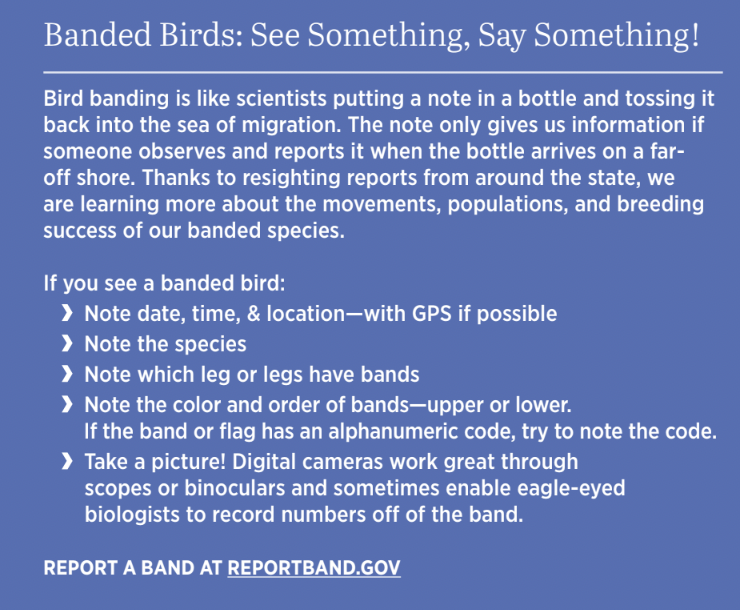For Audubon’s coastal team, every sighting of a bird band is a moment of discovery. Whether on the barrier islands of the Gulf Coast, the rooftops of Tampa, or the beaches of Northeast Florida, reporting bird bands moves science forward by giving researchers and land managers critical data they can use to protect birds and the places they need.
What are bird bands?
Bird bands are light metal bands applied to the legs of birds to make them individually recognizable when they are resighted. Only certain people with a permit from the federal and state government are allowed to oversee the handling of birds for this purpose. Bands are specifically designed to be lightweight, and their use must follow strict protocols to ensure the birds’ safety.
Audubon’s coastal team members and volunteers are constantly on the lookout for banded birds, which they carefully note and report after their surveys. In fact, one spectacular volunteer, Wendy Meehan, who was named Audubon Florida’s 2023 Volunteer of the Year, has submitted more than 4,000 records of banded birds!
What do bird bands tell us?
American Oystercatchers
American Oystercatchers prefer to nest on small reefs or islands away from shore, where they are not disturbed and the risk of nest or chick predation is lower. Unfortunately, as sea level rises and storms increase, these low-lying areas more frequently experience high tides that make nesting impossible. When this occurs, they lose access to their nesting habitat.
A recent study looked at the survival rates of American Oystercatchers, measured by banding and resight data, from 2007-2018 along a three-county area on Florida's Gulf Coast. During this time period, the study documented an increase in the number of hours that the region experienced high tides. Their analysis showed that as these “high tide hours” increased, the survival rates of the oystercatchers shrunk from .96 to .89—a 7.3% decline in annual survival.
Of note: Audubon North Carolina staff run the database for the American Oystercatcher working group, which contributed the critical resight data needed for this study.
Red Knots
Many Red Knots spend their winter season along the coasts of Florida, Texas, and Louisiana, putting them at risk of harm from algal blooms—which are predicted to increase as a changing climate increases Gulf of Mexico temperatures. Across the three different states, researchers banded 2,412 Red Knots between 2005 and 2019. These knots were resighted 4,078 times.
When comparing the resight data to red tide events, the study draws a sobering conclusion: “While overall apparent annual survival rates were similar across the three locations (0.768 – 0.819), several red tide events were associated with catastrophically low seasonal (fall) survival in Florida (as low as 0.492) and Texas (as low as 0.510).”
Red tide events could continually disrupt populations of Red Knots, which are already on the decline as food sources and habitat availability shrink. To protect them on their wintering grounds, we must address ongoing water quality concerns to reduce higher-than-normal nutrient levels reaching the Gulf of Mexico from agricultural and urban runoff.
Least Terns
Because beach habitat is often busy with human visitors, many beach-nesting birds are instead finding refuge on rooftops. While rooftop nesting colonies can be as productive as beach colonies and provide relief from most forms of disturbance, these chicks face a threat unique to rooftops: falling off.
From 2011 to 2022, under permits issued by the U.S. Geological Survey and Florida Fish and Wildlife Conservation Commission, past-Audubon Florida Director of Bird Conservation Marianne Korosy, PhD, and renowned bird biologist Beth Forys, PhD, (Eckerd College) conducted a study in which biologists placed colored bands on the legs of any Least Tern chicks they returned to a rooftop following a fall. With a squadron of volunteer rooftop monitors, co-author and Audubon Coastal Biologist Jeff Liechty set out to resight the birds they banded in later breeding seasons on beaches, piers, and rooftops throughout Florida.
Over the course of nine years, biologists banded a total of 168 healthy Least Tern juveniles that had fallen from 16 different nesting rooftops. Fifty of those birds were resighted a total of 347 times. Seven of the terns were resighted while nesting: three on nearby beaches, three at rooftop colonies in Pinellas County, and one on a Levy County beach. Resighting birds while they are nesting means they have survived to adulthood and are ready to raise the next generation of Least Terns.
The banding study also confirmed that at least 39% of those birds survived to one year of age. After one year of age, 82% of the terns survived each year thereafter. The data are valuable for understanding population dynamics and show that putting juveniles back on rooftops is a viable management tool for Least Terns and potentially other rooftop-nesting seabirds.
This article appeared in the 2024 Summer Naturalist magazine. Click here to read the full magazine.








